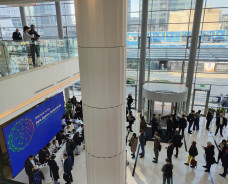In the heart of Vienna, the Natural History Museum Vienna (Naturhistorisches Museum Wien) served as the backdrop for an important gathering of Horizon Europe projects. Renowned for its historical significance and architectural grandeur, the museum became the hub of discussions centred on the intricate world of Biodiversity Data Cubes.
The attendees represented the sister projects B-Cubed, AD4GD, and FAIRiCUBE, and were embarking on a journey of collaborative exploration. The meeting started with representatives from each project introducing themselves and their projects, and the challenges they are aiming to resolve. This gave a comprehensive perspective on the potential synergies that could be forged. A recurring motif was the challenges associated with data access, interoperability, and the specialised expertise required to understand these data.
The discussions emphasised the use of standards and the adoption of specific file formats that could be important to support a broad user base. The importance of data sampling designs and the methodologies to extrapolate insights from unsampled locations were also brought to the fore. Discussions delved into the technical facets of Data Cubes, ranging from detailed discussions on dimensions, including Taxonomic, Temporal, and Spatial, to overarching considerations related to data measures, scales, formats, and accessibility.
Among the myriad of insights, AD4GD emphasised the utility of occurrence cubes to demystify the connectivity of landscapes and the role of environmental data cubes in chronicling historical data. We also examined the potential integration of Data Cube creation within their existing digital frameworks and its alignment with the ambition of the Green Deal Data Space.
In retrospect, the meeting was a fusion of ideas, expertise, and shared ambition, charting a promising path for the future of Data Cubes in environmental research and the provision of policy-relevant information.



